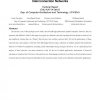Free Online Productivity Tools
i2Speak
i2Symbol
i2OCR
iTex2Img
iWeb2Print
iWeb2Shot
i2Type
iPdf2Split
iPdf2Merge
i2Bopomofo
i2Arabic
i2Style
i2Image
i2PDF
iLatex2Rtf
Sci2ools
PC
2010
2010
Reducing complexity in tree-like computer interconnection networks
The fat-tree is one of the topologies most widely used to build high-performance parallel computers. However, they are expensive and difficult to build. In this paper we propose two alternative tree-like topologies that are cheaper in terms of cost and complexity, because they are “thinner” than fat-trees: less switches, and less links. We test the performance of these narrowed trees, and compare it with that of the full-fledged fat-tree using a collection of synthetic patterns that emulate the behavior of well-known applications, including causal relationships among messages. Moreover, we do a performance/cost analysis of these networks. Our main conclusion is that, for the set of studied applications, performance of narrowed topologies is as high as that of fat-trees, with much less cost. Rearranging switch ports to use them as downward ports instead of upward ports do reduce bisection bandwidth, but also increases locality, which can be efficiently exploited by applications.
Related Content
| Added | 29 Jan 2011 |
| Updated | 29 Jan 2011 |
| Type | Journal |
| Year | 2010 |
| Where | PC |
| Authors | Javier Navaridas, José Miguel-Alonso, Francisco Javier Ridruejo, Wolfgang Denzel |
Comments (0)

